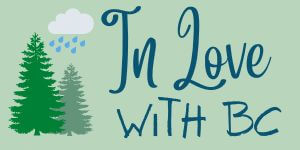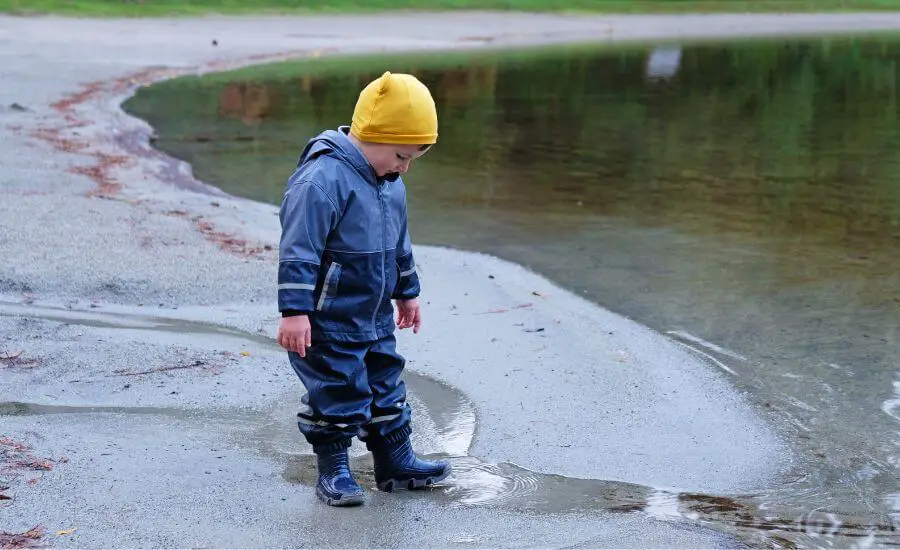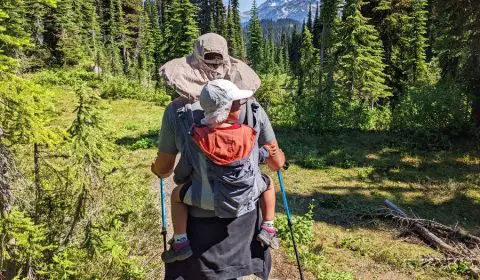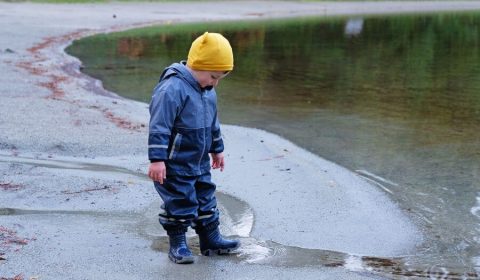What’s that one piece of outdoor gear we used most often when spending time outdoors with my son after moving to Vancouver? Right, a toddler rain suit. I’ve actually bought the first toddler rain suit for him in Vancouver, along with a pair of gum boots.
They made my time outdoors much less stressful (no need to worry about him getting wet and cold), and my son’s so much more enjoyable (jumping in the puddles and all that fun kids can find in the rain). As a bonus: they protect the rest of his clothing, so muddy adventures won’t result in doing laundry more often.
While buying rain boots were quick and simple, finding the suitable toddler rain suit required some research. This post is to help you choose the best rain suits for toddlers, including one-piece and two-piece rain suits, fleece-lined suits and toddler rain pants, so that you can have an enjoyable time outdoors, rain or shine.
Even if it’s been raining for several days, well, “go outside or go insane” – that’s surely the rule that applies to me and my son. 🙂
Things to consider when choosing a toddler rain suit
Size and fit
Obviously, it should be the right size. Don’t choose simply the 2-year-old model for your 2-year-old, also check the size chart. My son usually needs a bigger size than his age, because he’s tall. Your wallet will thank you if you also consider how much they’ll grow in the coming year.
Elastic cuffs and waistbands ensure a snug fit, and you can adjust the rain suit as needed.
Material
First thing first: it should be waterproof. It’s ideal if it’s also breathable, but we all know that while waterproof materials are cheap, those materials which are both waterproof and breathable are much more expensive. If your kid mostly wears the rain suit for short periods of time, I wouldn’t stress much about breathability. The main goal is to keep them dry while they’re jumping in the puddles.
Nylon and polyester are water resistant because of their tight weave, but they should be coated with a waterproof layer to be actually waterproof. They are both commonly used in rainwear, because they are affordable and versatile.
Gore-Tex is a waterproof and breathable fabric, but Gore-Tex rainwear comes with a certain price tag.
yes, I took the best pictures of this rain suit when we visited Royal National Park in Australia… 😀
PVC (Polyvinyl Chloride) is a cheap material that provides excellent waterproofness, but terrible breathability. It’s commonly used in heavy-duty rain gear (like the rain ponchos you get for free when you visit Niagara Falls).
Polyurethane is another synthetic material known for its excellent waterproof properties. It’s actually often used as a waterproof coating on other fabrics.
Durability
A toddler rain suit should be tough. Reinforced seams, sturdy zippers, tough materials, reinforcement panels help withstanding the frequent (and not very gentle) use.
Visibility
Reflective strips or bright colors enhance visibility in low-light conditions. It’s especially important if your toddler will be wearing the rain suit near roads or in dimly lit areas.
Freedom of movement
Toddlers move a lot, and clothes shouldn’t restrict them. Look for rain suits that have elastic cuffs, adjustable hoods and enough room for layering clothes underneath.
sleeping in a rain suit as a storm arrives to Glacier National Park
Cleaning
Don’t make your life more complicated. A rain suit should be easy to clean and maintain. Look for one that’s machine washable.
Insulation
Some rain suits have insulation, and with the proper layers underneath they can function as a snowsuit throughout the winter (not the Alberta winters, of course, it depends on where you live). But it’s an additional piece of rainwear, the default is the non-insulated one. If you buy only one, choose one without insulation, and bundle your kid in extra layers if it’s colder outside.
If you’ll buy a thicker insulated snowsuit, then again, you won’t need an insulated rain suit. One-piece rain suits trap the heat quite effectively, anyway, it’s easy for a toddler to get overheated in them on a warm day.
One-piece vs. two-piece rain suits
This one comes down to personal preferences – yours and your kids’. One-piece rain suits are surely better at keeping water out. But they tend to be a bit baggy around the waist, and they can’t be adjusted, so you’ll likely use them for one season only (or a full year if you live on the rainy West Coast :D).
Two-piece rain suits offer more flexibility, they usually have a better fit, and you can use only the coat or the pants. They are better for potty training. But they are not that effective for keeping the water out. They are for adults, but toddlers jump in mud puddles and fall as they run on muddy terrain.
Overall, I’m happy to compromise and use a one-piece rain suit even now that my son is almost 4 years old, because that’s what keeps him dry (and the rest of his clothes clean, too). But kids are different, and I know families who prefer two-piece rain suits for toddlers.
Best value for money: Cloudveil one piece rain suit for toddlers
The price of this all in one toddler rain suit is hard to beat. Despite the low price, it’s tough, durable and effectively keeps the water out. It served my toddler for a year – and it was a year full of outdoor activities and lots of rain and mud.
It’s easy to put on and take off thanks to the dual front zipper. This dual zipper worked well enough for potty training, as well. Reinforced seat and knee panels make it even more durable. Unlike many other clothes my boy uses, he didn’t tear this one, he simply grew it out.
sunshine after the rain
The breathability is not good, but that’s to be expected for such a cheap material. It looks a bit baggy, especially on skinny toddlers. But adding an extra layer underneath is surely not a problem. We used it as a three season rain suit, because with warm layers underneath, it was enough even on chilly spring or fall days.
Features:
- Zipper closure (dual zipper)
- Sealed seams
- Elastic cuffs (wrist and ankle)
- Reinforced seat and knee panel
Sizes: 12 months, 24 months, 2-3T
Check the price and purchase here.
Most versatile rain suit: Columbia Critter Jitters
Columbia is a very reliable outdoor brand, and the Critter Jitters won’t disappoint either. It’s quite cool, actually. It’s not only a good quality rain suit, it’s also breathable, has Velcro leg cuffs, elastic waist so that it won’t look baggy, an adjustable hood and a diagonal zipper to put it on and take it off quickly.
It’s perfect for little hikers, or kids who spend long hours outdoors, as the breathability is relatively good, and it has partial fleece lining. But it’s just as suitable for playing in the park or on the playground in wet weather.
The “Outgrown” system is a huge bonus: you can flip the suit inside out, snip the little threads to extend the legs and sleeves, and there you go, your toddler still hasn’t grown out of it (for a little more time at least).
It’s available in different cute colors and patterns.
Features:
- full length diagonal zipper
- elastic cuffs, elastic waist
- “Outgrown” feature to extend the life of the rain suit
Sizes: 0-3 months, 3-6 months, 6-12 months, 12-18 months, 18-24 months, 2T, 3T, 4T
Check the price and purchase here.
Best fleece-lined rain suit: JAN & JUL Cozy-Dry
Jan & Jul is headquartered in Vancouver, their clothes are tested by kids in the Pacific Northwest. Their motto matches that of the parents living in Vancouver: get into nature, no matter the weather.
This fleece-lined rain suit is designed for up to -10°C, which makes it a great rain suit (and snow suit) in the colder months not only in the Pacific Northwest, but in other mild winter climates, too. The fabric waterproof rating is 10000 mm, and it has an active breathability of 3000g/m2/24h.
Thanks to the adjustable hood, waist and elastic cuffs, it can grow a little bit as your toddler grows (but can’t keep up, obviously). However, the zipper is not full-length nor double, and it takes quite an effort to get the suit on.
It comes in a variety of colors and patterns, and they’re adorable.
Features:
- fully taped seams
- adjustable hood with rain brim
- elastic cuffs
- fleece-lined
Sizes: 1T, 2T, 3T, 4T, 5T, 6T
Check the price and purchase here.
Best affordable one piece rainsuit for older toddlers: JiAmy hooded rain suit
While the Cloudveil rain suit is a great and affordable one, it doesn’t offer a model for 3+ year-olds. This model is similar, made of lightweight, tough and waterproof material. It has a wide enough brim to protect the hair from getting wet.
Breathability is not its strength though. Also, the zipper is not full-length nor a double zipper, and it makes it more of an effort to get the rain suit on (and possibly reduces its lifetime).
It offers sizes from 1 to 7 year-olds. It’s better for older kids as the sizes cover a wider range (S, M or L).
Features:
- sealed seams
- adjustable hood with rain brim
- elastic cuffs
Sizes: 1-7 years
Check the price and purchase here.
Best two piece rain suits: LZH rain coat and pants
This two piece rain suit is comfortable and breathable. It has fleece lining inside, so it’s definitely for the colder months. But the advantage of the two piece set is that you can use only the jacket or only the pants so that your kid doesn’t get overheated.
It’s waterproof, but naturally, it won’t keep the water out if your kid jumps into the puddle – or swan dives into the puddle.
They offer matching pieces in several cute patterns and colors, both for boys and girls.
Features:
- zipper jacket with pockets
- fleece-lined
Sizes: 9 months – 6 years
Check the price and purchase here.
Best unisex rain pants: JAN & JUL single layer rain pants
If you only need single layer rain pants for playing out after the rain, or protecting the pants underneath, this unisex model from Jan & Jul is a great option. The fabric waterproof rating is 10000 mm, and it has an active breathability of 3000g/m2/24h (same as their rain suits).
The elastic waistband and adjustable drawstring makes it easy to put the pants on, and it rolls up small so that it fits into a small pocket of a backpack.
It’s great as a standalone wear, and also as an outer layer in the colder months.
Features:
- fully taped seams
- elastic waistband and ankle bands
- two pockets
Sizes: 1 – 10 years
Check the price and purchase here.
Finally, but most importantly: make sure the rain pants actually keep the water out
To make the set complete, you definitely need a pair of rain boots. And your toddler needs to wear them correctly to keep the water out: the pants should go over the boots!
In lots of pictures of toddlers in rain suits, the pants are tucked into the boots. This makes the rainwear useless, because water will drip down the pants and into the boots. As your toddler jumps into a paddle, water will splash into the boots, too. The pants should go over the boots in order to keep your toddler dry.
Which are the best kid-friendly parks in Metro Vancouver?
Sign up and get our free e-book:












